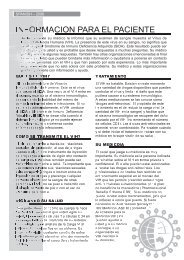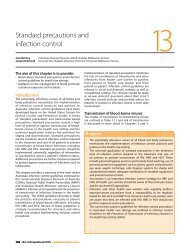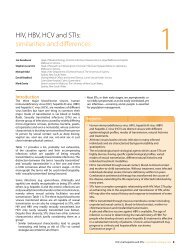B Positive – all you wanted to know about - ASHM
B Positive – all you wanted to know about - ASHM
B Positive – all you wanted to know about - ASHM
You also want an ePaper? Increase the reach of your titles
YUMPU automatically turns print PDFs into web optimized ePapers that Google loves.
Paediatric management<br />
for a neonate born <strong>to</strong> a mother with HbV<br />
infection, hepatitis b vaccination reduces the<br />
risk of infection by 70%; the addition of HbiG,<br />
derived from the plasma of blood donors<br />
with high anti-Hbs levels, augments this risk<br />
reduction <strong>to</strong> 90%. 5 this combined active and<br />
passive vaccination approach for the prevention<br />
of perinatal infection is outlined in table 10.2.<br />
children diagnosed with HbV infection should<br />
be referred <strong>to</strong> a paediatrician experienced in<br />
viral hepatitis.<br />
acute HbV infections in infants and children<br />
are more commonly asymp<strong>to</strong>matic than<br />
these infections in adults, but when clinical<br />
manifestations do occur, they are gener<strong>all</strong>y<br />
similar <strong>to</strong> those in adults. fulminant disease<br />
is uncommon, but in infants it appears<br />
<strong>to</strong> be associated with maternal Hbeagnegative<br />
chronic hepatitis. Most chronic<br />
infections are asymp<strong>to</strong>matic and do not affect<br />
development. 6<br />
the management principles for children with<br />
chronic HbV are gener<strong>all</strong>y the same as those<br />
for adults (see chapter 5: Primary prevention of<br />
hepatitis b virus infection, chapter 7: treatment<br />
of chronic hepatitis b virus infection, chapter<br />
8: Managing patients with advanced liver<br />
disease, chapter 9: Hepatitis b virus-related<br />
hepa<strong>to</strong>cellular carcinoma). counselling the<br />
patient and family regarding the natural<br />
his<strong>to</strong>ry of the disease, modes of transmission<br />
and treatment options should be undertaken.<br />
<strong>all</strong> susceptible household members should be<br />
vaccinated against HbV, and the affected child<br />
should also be vaccinated against hepatitis<br />
a. as with adults with chronic HbV infection,<br />
children should be periodic<strong>all</strong>y moni<strong>to</strong>red<br />
for disease activity, progression and the<br />
development of hepa<strong>to</strong>cellular carcinoma.<br />
although there are even less data informing<br />
the frequency of moni<strong>to</strong>ring in children than<br />
in the adult context, annual screening for<br />
Hcc with serum alpha fe<strong>to</strong>protein testing has<br />
been recommended, <strong>to</strong>gether with periodic<br />
table 10.2: Prophylaxis for perinatal hepatitis b virus exposure<br />
1. HBIG* 100 iu, iM, single dose<br />
2. Hepatitis B vaccine 0.5 mL, iM, 4 doses at 0, 2, 4 and 6 or 12 months<br />
3. other considerations:<br />
� Preferably both HbiG and hepatitis b vaccine should be administered immediately after birth in<br />
opposite thighs (i.e. not in<strong>to</strong> the same site)<br />
� HbiG should not be delayed beyond 12 hours after birth<br />
� Hepatitis b vaccine should be given within 24 hours of birth; if delay is unavoidable, vaccine must be<br />
given within seven days<br />
� doses of hepatitis b vaccine subsequent <strong>to</strong> the birth dose are combined vaccines as per the standard<br />
schedule (final dose at 6 or 12 months depending on vaccine used)<br />
� serological assessment for infection (Hbsag and anti-Hbs) should be performed three months after<br />
the final dose of hepatitis b vaccine (not before nine months of age)<br />
* Hepatitis b immunoglobulin (HbiG) is only available through the australian red cross blood service<br />
liver ultrasounds, and clinical and biochemical<br />
moni<strong>to</strong>ring of disease activity every six <strong>to</strong> 12<br />
months. 6<br />
the selection of patients for antiviral therapy<br />
is similar <strong>to</strong> the adult context. treatment is<br />
gener<strong>all</strong>y reserved for patients with aLt values<br />
repeatedly more than twice the upper level of<br />
normal, as treatment efficacy is much higher<br />
in this setting (see chapter 7: treatment of<br />
chronic hepatitis b virus infection). the available<br />
treatments are conventional interferon-alfa and<br />
lamivudine. 6,7 the advantages of interferon-alfa<br />
are the finite duration of therapy and the lack of<br />
induction of antiviral resistance. both efficacy<br />
and <strong>to</strong>xicity profiles in children are similar <strong>to</strong><br />
those in adults, and patients with normal aLt<br />
(being the majority of children who acquired<br />
the infection at birth) are unlikely <strong>to</strong> achieve<br />
favourable outcomes. the use of pegylated<br />
interferon <strong>to</strong> treat HbV in children has not<br />
yet been investigated (but was examined<br />
b <strong>Positive</strong> <strong>–</strong> <strong>all</strong> <strong>you</strong> <strong>wanted</strong> <strong>to</strong> <strong>know</strong> <strong>about</strong> hepatitis b: a guide for primary care providers 77






